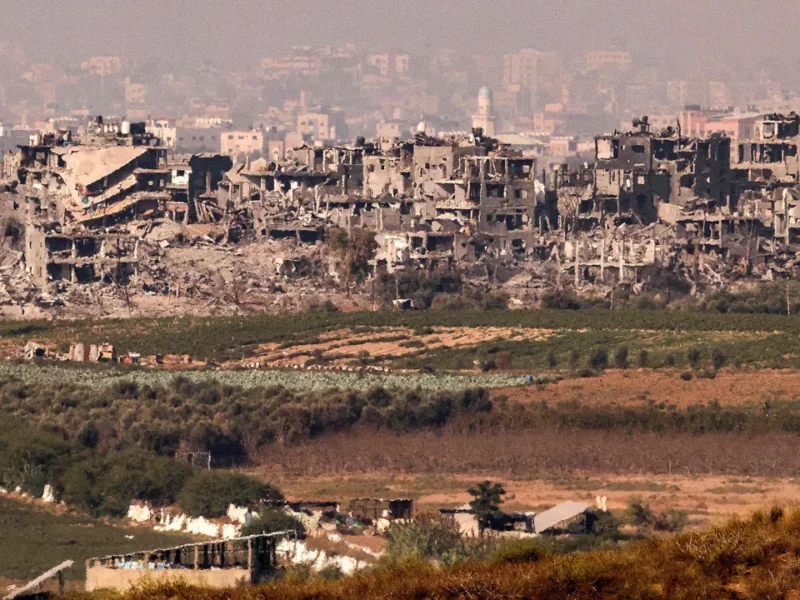Israel’s military operation against Hamas has the potential to significantly set back the Palestinian economy in both Gaza and the West Bank, as indicated by a recent analysis conducted by the United Nations Development Programme (UNDP).
A report published on Thursday by the UNDP presents a bleak outlook for the economic situation in the Palestinian territory. In response to the terror attack in Israel on October 7, which the Palestinian Ministry of Health in Ramallah reports resulted in more than 10,700 casualties, economic conditions in the region have deteriorated. Since the onset of the recent conflict, over 300,000 more Palestinians have fallen into poverty, according to Abdallah Al Dardari, who serves as the director of the UNDP Regional Bureau for Arab States.
The fighting that began last month has led to the displacement of nearly 1.5 million people in Gaza, according to the United Nations Relief and Works Agency. Concurrently, Israel’s blockade on fuel and severe restrictions on the delivery of food, water, and medical supplies have given rise to a humanitarian crisis.
The UNDP analysis reveals that critical economic indicators, including employment rates and GDP, have experienced significant declines in both Gaza and the West Bank. Specifically, the past month of conflict has resulted in a 61 percent reduction in employment in Gaza and a 24 percent decrease in employment in the West Bank. Palestinian GDP is expected to have decreased by 4.2 percent after one month of war compared to pre-war estimates, representing a loss of approximately $857 million. If the conflict extends into a second month, this figure could rise to $1.7 billion, equating to an 8.4 percent decline in GDP, as stated in the report.
Al Dardari expressed the enormity of the situation, stating in an interview, “This is of immense scale. I’ve been observing conflicts for three decades and documenting them, but I have never witnessed such a dramatic and rapid upheaval.” He shared these remarks with CNN.

On October 18, 2023, an Israeli airstrike demolished a bakery located in the Nuseirat Refugee Camp in Deir al Balah, Gaza.
Prior to Israel’s military campaign in October, the poverty situation in Gaza was already dire, with the World Bank reporting that 61 percent of the population lived below the poverty line in 2020.
For the past 17 years, access to this densely populated enclave, which is home to approximately 2 million people, has been significantly restricted by Israel and Egypt, a situation frequently criticized as an “open-air prison” by the non-governmental organization Human Rights Watch.
The recent escalation of conflict has exacerbated the economic hardships faced by the population. According to the UNDP report, within one month of the conflict, the number of individuals living in poverty in both Gaza and the West Bank increased by nearly 20 percent. If the war were to persist for a second month, the total rise in the impoverished population would exceed 34 percent, affecting approximately 500,000 people, as stated by Al Dardari.
In a densely populated area, extensive structural damage has occurred during the four-week Israeli campaign. Nearly half of the housing stock is reported to have been damaged or destroyed by the bombardment, and 40 percent of educational facilities have been damaged, as per the United Nations Office for the Coordination of Humanitarian Affairs.
The UNDP report predicts a setback of 11 to 16 years in a metric called “human development” across Gaza and the West Bank due to the ongoing conflict. This estimate is based on an assessment of educational, health, and economic indicators that contribute to the Human Development Index.
If the fighting were to continue for a second month, the Palestinian economy would face a setback equivalent to 19 years of development, according to Al Dardari. This means a return to the conditions of 2001 or 2002, erasing all progress made in human development, health, education, business, and growth since then.
Israeli officials have not provided a specific timeline for the military operation in Gaza, but they have indicated that it is expected to be a lengthy endeavor with the goal of completely eliminating Hamas. Prime Minister Benjamin Netanyahu has insisted on not approving a ceasefire until around 240 hostages being held in Gaza are released.
There are concerns about the post-war management of Gaza, with Netanyahu suggesting that Israel should have “overall security responsibility” in the Palestinian enclave for an “indefinite period.” However, his advisors clarified that this refers to security control, not governing power.
UNDP has not estimated the costs of reconstruction in Gaza after a ceasefire due to uncertainty about the campaign’s duration. Al Dardari mentioned that UNDP would likely be involved in the reconstruction process, but a continued Israeli blockade could complicate these efforts, as massive reconstruction and a blockade are challenging to reconcile from a technical perspective.

Palestinians use animal-drawn carts to move from north Gaza to the south, amidst the ongoing conflict between Israel and the Palestinian Islamist group Hamas in the central Gaza Strip. This took place on November 9, 2023, and the photo credit goes to REUTERS/Mohammed Salem.











